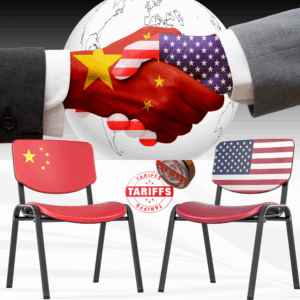
Today’s major development on the global trade front: the United States and China have agreed to a 90-day suspension of key tariffs, signaling a notable step toward easing long-standing tensions between the world’s two largest economies. The breakthrough, which came after intensive weekend negotiations in Geneva, was facilitated by Swiss diplomatic channels and marks a turning point in an economic standoff that has persisted for years.
A Shift Toward Resolution:
After months of high-stakes negotiations and economic posturing, President Donald Trump and his administration have shown a more conciliatory tone. Trump hinted at a substantial reduction in tariffs—from an initial rate of 145% down to 80%—on Chinese imports. While the exact structure of the new trade framework remains under wraps, insiders confirm that both countries have committed to reciprocally reducing tariffs by a total of 115%.
US Treasury Secretary Scott Bessent, who led the US delegation along with Ambassador Jamieson Greer, stated that the 90-day suspension will apply to a wide range of previously targeted goods. This provisional arrangement is expected to serve as a confidence-building measure while the two sides work out the details of a more comprehensive long-term trade agreement.
Constructive Dialogue in Geneva:
Describing the talks as “productive and surprisingly swift,” Ambassador Greer highlighted the constructive atmosphere that defined the discussions. The Swiss government’s involvement was instrumental in facilitating neutral ground for both parties to engage openly.
According to Bessent, China’s delegation, led by the vice premier and other senior ministers, showed a strong willingness to cooperate. Both sides maintained close communication with their respective leadership throughout the process.
What’s Changing Now?
As per the joint announcement, here’s what the initial terms include:
- The US will cut tariffs on Chinese goods to 30%.
- China will lower its tariffs on American imports to 10%.
- A 90-day suspension of a broad range of tariffs will take immediate effect.
- Both countries will work toward a gradual reduction totaling 115%, easing pressure on industries and consumers alike.
These adjustments, though temporary for now, suggest a strategic pause that may help businesses realign, recover, and prepare for the possibility of a more balanced bilateral trade relationship.
Why This Matters:
This trade de-escalation comes at a critical moment. The US is currently grappling with a $1.2 trillion trade deficit, prompting President Trump to previously declare a national economic emergency. The imposition of severe tariffs had placed considerable strain on industries ranging from tech and manufacturing to agriculture and retail—on both sides of the Pacific.
By agreeing to this truce, both countries may be aiming to stabilize their economies and restore investor confidence, particularly with global markets closely watching their next moves.
What to Watch Next:
While the 90-day tariff freeze is a welcome development, experts warn that the true test lies ahead—in how both countries navigate the complexities of trade balance, intellectual property rights, and market access.
For now, this diplomatic breakthrough offers hope for renewed cooperation, lower import costs, and reduced economic uncertainty—benefits that will likely ripple across global supply chains and consumer markets.
Disclaimer:
This article is based on publicly available information and official announcements related to recent trade negotiations between the United States and China. It is intended for informational and editorial purposes only. All names, titles, and statements mentioned reflect reports from government sources and public statements, and no copyrighted material has been used or reproduced in this content.